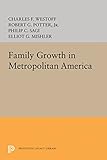Family Growth in Metropolitan America / Charles F. Westoff.
Material type: TextSeries: Office of Population Research ; 1953Publisher: Princeton, NJ : Princeton University Press, [2015]Copyright date: ©1961Description: 1 online resource (456 p.)Content type:
TextSeries: Office of Population Research ; 1953Publisher: Princeton, NJ : Princeton University Press, [2015]Copyright date: ©1961Description: 1 online resource (456 p.)Content type: - 9780691625737
- 9781400876419
- 301.32 22
- HQ766.5.U5 W4eb
- online - DeGruyter
- Issued also in print.
| Item type | Current library | Call number | URL | Status | Notes | Barcode | |
|---|---|---|---|---|---|---|---|
 eBook
eBook
|
Biblioteca "Angelicum" Pont. Univ. S.Tommaso d'Aquino Nuvola online | online - DeGruyter (Browse shelf(Opens below)) | Online access | Not for loan (Accesso limitato) | Accesso per gli utenti autorizzati / Access for authorized users | (dgr)9781400876419 |
Frontmatter -- Foreword -- Preface -- Contents -- Tables -- Part I. Introduction -- Chapter I. Background, Objectives, and Approach -- Chapter II. Study and Sample Design -- Chapter III. Methodology -- Part II. Fertility Variables -- Introduction to Part II -- Chapter IV. Fecundity -- Chapter V. Contraception -- Chapter VI. Birth Intervals -- Chapter VII. Preferred Birth Intervals -- Chapter VIII. Desired Family Size -- Chapter IX. Summary of the Fertility Variables -- Part III. Social and Psychological Determinants -- Chapter X. Concepts and Hypotheses -- Chapter XI. Religion, Class, and Fertility -- Chapter XII. Religiousness -- Chapter XIII. Socio-Economic Status -- Chapter XIV. Social Mobility -- Chapter XV. Residence and Migration -- Chapter XVI. Age and Sex Composition of the Family -- Chapter XVII. Social Relations within the Family -- Chapter XVIII. Personality Characteristics -- Chapter XIX. Summary Multivariate Analysis -- Part IV. Resurvey -- Chapter XX. The Next Phase of the Study -- Appendices -- Appendix A. Supplement to Chapter IV -- Appendix Β. Supplement to Chapter V -- Appendix C. Index Construction -- Appendix D. Significance Levels of Correlation Coefficients -- Appendix Ε. Related Publications -- Author Index -- Subject Index
restricted access online access with authorization star
http://purl.org/coar/access_right/c_16ec
This analysis is based upon a study of 1,165 couples, all of whom had two children by the time of the interviews and lived in one of the Standard Metropolitan Areas. Its findings shed new light on the relationship between fertility-planning behavior and such variables as socio-economic status, social mobility aspirations, adherence to traditional values, interest in religion, marital adjustment, amount of education, and feelings of personal adequacy. A resurvey is planned for three years later, to analyze subsequent attitudes and behavior.Originally published in 1961.The Princeton Legacy Library uses the latest print-on-demand technology to again make available previously out-of-print books from the distinguished backlist of Princeton University Press. These editions preserve the original texts of these important books while presenting them in durable paperback and hardcover editions. The goal of the Princeton Legacy Library is to vastly increase access to the rich scholarly heritage found in the thousands of books published by Princeton University Press since its founding in 1905.
Issued also in print.
Mode of access: Internet via World Wide Web.
In English.
Description based on online resource; title from PDF title page (publisher's Web site, viewed 30. Aug 2021)


